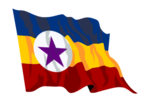Americani aut non Americani?
| This page has been superseded and is obsolete or decanonized, and it is retained primarily for historical interest or will be reworked to fit the current canon. |
| Part of a series on the |
| Culture of the Kingdom of Sierra |
|---|
 |
| Kingdom of Sierra portal |
Americani aut non Americani? (Latin: Americans or not Americans?) is a cultural question and political issue predominantly associated with Sierra, its people, and the issue of Sierran national identity. Americani aut non Americani reflects the identity crisis that Sierra endures from being erroneously compared to or mistaken for that of the culture, conventions, or image of the United States, or the question on whether Sierran culture is a distinct one, or merely a variant of American culture. The question is also a relevant issue in Brazoria, Canada, and the Confederate States. The question was first posed by Sierran sociologist Chris Sorensen in 1963 through his published work, The Development and Rise of the Sierran Nation.
Sierra gained its independence from Mexico officially in 1858 through the Treaty of Guadalupe Hildago but its citizens were mostly of Anglo-American descent who immigrated to the region decades prior. Heavily influenced by America, Sierra nonetheless generally resisted attempts of overt American influence on its politics in spite of strong cultural ties. Through the early 20th century, the Sierran Cultural Revolution helped spawn the ubiquitously Sierran culture that has continued to prevail in contemporary times. However, due to mounting political pressure, geographical proximity, and America's rise to power, Sierra's identity became threatened with America's. In the 1990s, following Sierra's strengthening ties with America, Sorensen's question Americani aut non Americani? gained popular traction and coverage. Many aspects of Sierran culture such as Hollywood, car culture, the fast food industry are commonly misconstrued as originally "American" leading observers to qualify the question that Sierra is "American".
Origin
The question first appeared in Sierran sociologist Chris Sorensen's book, The Development and Rise of the Sierran Nation, published in 1963. Discussing the influence of the United States over Sierra's development as a country, Sorensen argued that the American culture of individualism and expansionism helped drive Sierra's creation and progression. Although Sorensen stated that Sierra was not America, he believed that it was an American nation in the cultural sense.
"Americanism is in no doubt, deeply woven into the Sierran national fabric. From the very beginning, this has always been the case with the Bear Flag rebels of American origins, and none else. When the Constitution was being written, the majority of the delegates were Americans and much of the text was modeled directly from America's. Despite all the herculean efforts the Sierran nation has tried to distance itself from America as its own nation, there is a prevailing feeling that perhaps Sierra is not Sierran at all but merely an extension of the American culture. Like Canada, with its own Anglicanisms and clear links to the Albish nation, Sierra too likewise, owes to much part, its existence to America for its Americanisms. Quid facit nos serrae? What makes us Sierrans? The Sierran nation has gone through great lengths to answer such a question yet still, to no avail, the sense of "American-ness" persists. Americani aut non Americani? Americans or not Americans? This is the question that must be asked among ourselves if we are to truly consider ourselves as a nation in our own right, at least in the cultural sense."
— Sorensen, Chris. The Development and Rise of the Sierran Nation, p. 12
Context
Between the 16th and 18th century, Spain held control over present-day mainland Sierra. Following the Mexico's independence in the early 19th century, Sierra became part of Mexican land. Known as California at the time, many Anglo-speaking immigrants from the United States and Britain arrived bringing their own customs and traditions to the land. Although Mexican law required the Americans to adopt Catholicism as their official religion and learn to speak Spanish, many Americans ignored such legal requirements and formed their own communities. With increased tension between Mexican officials and American settlers, calls for an independent California grew stronger. Eventually, both the Americans and the Mexican Californios (who were born on the land instead of mainland Mexico further south) revolted and declared the California Republic. Eventually, through the Mexican-American War and the signing of the Treaty of Guadalupe Hildago, California gained its independence and later reformed itself as the Kingdom of Sierra.
The newly created Kingdom was built upon the new constitution which borrowed heavily from the American constitution. Although there were monarchist elements to the document, much of it directly incorporated text from the American constitution including the Bill of Rights. Early Sierra struggled to maintain its own national identity where many of its people remained loyal to their former nationalities: American or Mexican. In addition, Sierra faced the ongoing diplomatic pressure of its neighbor states, particularly the United States, who held large commercial interests in the country.
Although Sierra developed its own unique and distinct culture and political traditions by the 20th century (through the Sierran Cultural Revolution), and had an semi-isolationist policy, it was often tied with the United States, especially among foreigners. Many Americans at the time perceived Sierra and the other Anglophone nations as another region of America, rather than countries by their own right. With enough similarities in culture, language, ideology, and history, the blurred distinction between Sierra and the United States were further complicated when Sierra joined the Conference of American States, a supranational union geared towards North American political integration.

